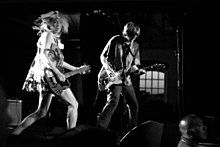Indie rock
|
Indie rock
|
|
| Development phase: | Early 1980s |
| Place of origin: | United Kingdom and United States |
| Stylistic precursors | |
| Power Pop • Folk Rock • Garage Rock • New Wave • Post-Punk | |
| Instruments typical of the genre | |
| Guitar • bass • drums • vocals • keyboard | |
| Stylistic successor | |
| Britpop • Alternative Rock • Dream Pop • Hamburg School • Indietronic • Math-Rock • Noise-Rock • Paisley Underground • Post-Rock • Indie-Folk | |
Indie rock (also known as independent rock or simply indie ) was originally rock music in the broadest sense of the word, which was distributed exclusively by independent labels . Meanwhile, indie rock is a collection of several subgenres such as B. of alternative rock . Indie rock has now become popular with the masses. The name for the indie rock was the independence (English independence ) from the big record companies ( major labels ).
history
While mainstream rock continued to develop in the 1970s and began to endure in bombastic arrangements, very elaborate productions and staged stage shows, the punk hype and the NWoBHM founded bands whose goal it was again, the youngsters Expressing aggression. Due to the rejection of "commerce" by the punks and the lack of commercial suitability of heavy metal , a large part of this music was distributed by independent labels. The term indie rock was also used as a synonym for music that was difficult to market, but attempts were still made to categorize it using musical criteria.
During the 1980s, rock music generally fell out of the focus of mainstream music. Hip-hop , disco music and the profit-oriented New Wave were on the rise and creative rock artists now only came from underground scenes. Various sub-genres from death metal to hardcore punk to post-punk developed without any prospect of commercial success .
Increasing popularity
Central to this are The Stone Roses and The Smiths , whose music incorporates elements from garage rock , British Invasion , classic punk and rock 'n' roll . However, with the exception of the Smiths in Great Britain, these bands only appealed to a smaller audience. Her musical influence only came to bear later. In the USA, too, an indie rock scene had developed by the end of the 1980s, with a musical spectrum ranging from bands influenced by New Wave such as the Pixies or They Might Be Giants to more experimental rock music (e.g. Sonic Youth ) to groups that can be regarded as precursors to grunge (such as Dinosaur Jr. or Green River ).
At the beginning of the 1990s, rock music, which was redefined in subcultures, had such a broad impact that the music industry began to invest more heavily in this area again. A direct consequence of this was the grunge boom around nirvana . In the course of the grunge hype, music bands who played guitar-heavy, riff-oriented rock came into the public eye again. Bands like Nirvana and Rage Against the Machine took the classic rock elements of heavy metal , punk and blues rock back into their music. Music that was previously marketed by independent labels and was only an alternative (therefore alternative rock ) to mainstream music was able to post commercial success again.
The term indie rock became known to a wider public especially at the end of the 1990s and the beginning of the new millennium. Important representatives of indie rock in this phase include Death Cab for Cutie , The Strokes , The Hives and The Libertines . If you compare the bands mentioned, it is noticeable that the term indie rock is very versatile and actually encompasses many different styles of music. The Britpop , which especially in the 1990s by British bands such as Oasis , Blur u. a. became popular, many see it as a sub-genre of indie rock. Newer British bands such as B. Bloc Party , Franz Ferdinand or Kaiser Chiefs are strongly reminiscent of the music of these bands, so that a distinction between indie rock and Britpop is actually hardly possible and both terms appear again and again, both in connection with the newer bands from England and with older bands like Oasis and Blur. In contrast to the term indie rock, however, the term Britpop was rejected by most of the bands that were assigned to this genre by the media; Oasis in particular have always distanced themselves from the term Britpop .
today
At the moment the term indie rock is very popular because there are always new, always very new bands whose music, even if it is often very different, is assigned to the term indie rock. In general, this current downright indie trend can be compared with the beginning of the punk movement at the end of the 1970s, which also took place particularly in England and has many parallels to the so-called "mainstream". Besides England, most of the currently known indie bands come from the USA and Sweden. Indie rock has also been represented in German-speaking countries by its own bands since the early 1990s. Bands from the Hamburg School , who combine German lyrics with guitar music and a typical attitude, such as Tocotronic , Blumfeld or Die Sterne, are considered pioneers in Germany .
literature
- Albert Koch: Fuck Forever - The Death of Indie Rock . Hannibal Verlag, Höfen 2007, ISBN 978-3-85445-282-9
Web links
- indiepedia.de - a German-language wiki on indie and pop culture
- Thomas Freitag: Indie rock debate - How anti can pop be? Temporary article online from April 27, 2011.
Individual evidence
- ^ Indie rock Allmusic.com


